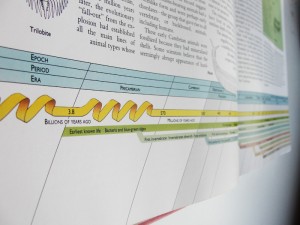The artist Andrea Polli’s interviews with Geoscience researchers in the Antarctic[1] first drew my attention to our tendency to think of time in terms of human life scales. A Geologist laments the misreadings of the earth’s processes this creates. Environmental psychologists in turn study how our short-term perspectives on time affect our attitudes to the environment.
Yet deep or geologic time –with its immense scale and complexity – holds a level of abstraction that most people find difficult to conceptualize,[2] including for students of Geology.[3] The Geologist and Geophysicist James Hall commented in 1788, “the mind seemed to grow giddy by looking so far into the abyss of time’, thus holding a sense of awe and terror.
In looking at attempts to diagram geologic time, I began to notice that for practicality reasons (printable space on the page, etc), you never saw this timeline fully to scale. Those things deemed interesting to us (dinosaurs to today) are shown fully expanded, while often everything prior is presented intensely condensed, if at all.
What did it look like fully outstretched?
I had first thought to demarcate a walk through the geologic timescale on the farm property for retreat guests to enjoy. But where and how? To what scale? A conversation had begun with Danish curators Majken Kramer Overgaard and Christian Villum about developing a simultaneous/simulcast dinner and workshop event around the topic of time, to be a part of an upcoming festival there, Platform4.0.Future Meeting Hub #1 (http://www.platform4.dk/node/72). Creating the walk as a workshop, seemed a way to open out that learning process to others. We would, as Bourriaud discusses, create a ‘projection of the symbolic onto the real’ – and in this case onto what was serendipitously handy – farmland and it’s paraphernalia.
I found a long history of creating physical walks through geologic time – known as ‘Cosmic Walks’. Originally developed by a nun, Dominican Sr. Miriam MacGillis, these walks have since been adapted into many different versions. Usually done as a spiral, they also involve a script that a group can follow as they walk the line or spiral. It was great to find this history and different versions, though was less interested in the style of language and delivery, more interested in a allowing this complexity to create a conversation. Paraphrasing curator Steve Dietz from his thoughts given in a discussion around curatorial ontologies, ‘it should create a platform that does the opposite of fixing meaning and allows for personal, communal, and opposing points of view to be argued and emerge’.[4]
I was also more generally curious to learn about what the geology of Miranda had been in prior eons. How might that knowledge affect my sense of this place – my home – and so in turn of my sense of identity?
[1] Polli, A. “Ground Truth.” Part 2, from http://www.youtube.com/watch?v=v7T-hM6EL14. Comments from Dr. Adam Lewis, North Dakota State University, Geosciences. 0:50.
[2] Gould, S. J. (1987). Time’s arrow, time’s cycle. Cambridge, Harvard University Press.
[3] Dodick, J. O., Nir (2003). “Cognitive Factors Affecting Student Understanding of Geologic Time.” Journal of Research in Science Teaching 40: 415–442.
[4] Steve Dietz, CRUMB discussion list, 8 Sep 2004

